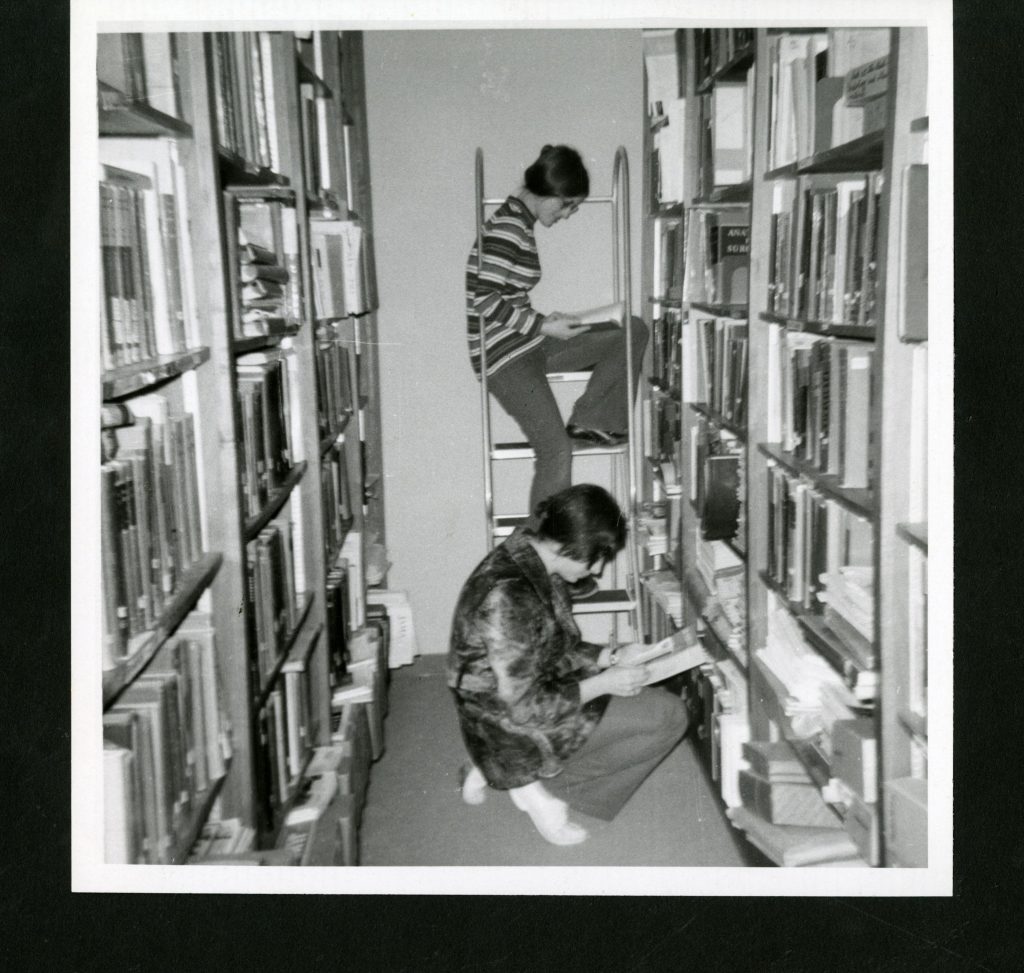In Stephens’ (2025a) lecture on participatory service and transparency, the concept that libraries create and facilitate connections can be corroborated by reflecting on social and intellectual relationships between library users (and staff) whose interactivity can form a meaningful network.
I work as a high school librarian at a small, independent all-girls school in New York City, where our library is divided into two rooms: a collaborative side and a quiet focus side. I manage the quiet focus side, however, the “quiet” part has become a more flexible term. The other collaborative side is regularly used as a subject classroom, leading my side to be the only library space in the high school. As a result, faculty and students often utilize my side to work or study together at a reasonable volume that still allows for independent workers to focus. I occasionally have teachers come in who are surprised by the lack of silence, comment on the noise, and/or leave. During my first year working in this position, this regularly stressed me out––was I perceived as unprofessional, unable to control the room, apathetic to chaos?
Now, as I just wrapped up my second year in this role, I have found a bit more inner peace about how “shhh!” does not earn you respect, nor does it really work. What has worked instead is knowing every single high school student by name, them knowing me, and having flexibility, patience, and a sense of humor. By trying to foster a library space that is welcoming, comfortable, and clear in its expectations––an ongoing effort––it transforms into an environment that is socially and intellectually engaging and adaptive to change. As Ranganathan stated in his 1931 Five Laws of Library Science, “the library is a growing organism.” And through evolution and growth, “there will always be some amount of chaos” (Stephens, 2025b). For school librarians with teenage users, we cannot be apathetic to this chaos nor try to fully control it, but rather be aware of it and let it inform our paths forward.
When a library feels accessible, users exploring its resources can go deeper to forge new meaningful connections. Young people are navigating the world with very different (digital) tools that the generations before them are not familiar with. For many digital natives, the digital and the physical world are not totally divorced from each other; technology is integrated into their daily lives (Stephens, 2010). School librarians have an exciting, if not slightly daunting, opportunity to engage with their students in order to gain a better understanding of how youth are socializing, learning and living, and how the hyperlinked school library can best support them. A healthy and consistent relationship between youth and the library paves the way for lifelong learning (Stephens, n.d.). The library can be a model for experimentation and collaboration, where connections between knowledge and community get established, and users can make sense of the world.
If schools have the mission and vision to embrace curiosity, allow for diverse discussions, and promote the acquisition of knowledge and critical thinking, then the library has an important role to play. Schools continue to face deep budget cuts to their libraries, or have no formal libraries at all, leaving its user (and nonuser) community isolated from technological growth and without an equalizing educational space. While not designed to be profitable “engines of productivity,” the hyperlinked libraries of today are indispensable for learning, where connectivity is the foundation and the future (Mattern, 2014).
In a contemporary educational landscape often focused on measurable outcomes, the school library stands apart; its essential value lies not in making a product, but in its unique capacity to cultivate the social and intellectual connections crucial for today’s youth communities, as chaotic as they may appear to be.

References
Mattern, S. (2014). Library as infrastructure. Places Journal. https://placesjournal.org/article/library-as-infrastructure/?cn-reloaded=1
Stephens, M. (2010, March 2). The hyperlinked school library: Engage, explore, celebrate. Tame the Web. https://tametheweb.com/2010/03/02/the-hyperlinked-school-library-engesexplore-celebrate/
Stephens, M. (2025a). Participatory service and transparency [Lecture recording]. SJSU. https://sjsu-ischool.hosted.panopto.com/Panopto/Pages/Viewer.aspx?id=2a19a4b6-e945-4d2e-abf1-aef3014172a5
Stephens, M. (2025b). “Historic” hyperlinked library model [Lecture recording]. SJSU. https://sjsu-ischool.hosted.panopto.com/Panopto/Pages/Viewer.aspx?id=a0569381-4d66-4e0a-a7fa-aab3010a8f3e

Hi Jane,
I absolutely love that you have intentionally created space to be known and truly know your students! I literally got teary reading how you have brought your values into the library and made it a welcoming and comfortable place for students to be. I think this will be far more impactful than enforcing a quiet space plus what a beautiful way to foster a lifelong love and appreciation for the library!
Hey Jane! I worked as a French teacher at Cathedral High School for a few years (also all-girls, Catholic), so I get it! Though when I was there I don’t even think we had a library, which was a real shame. (Admittedly, I was there before the complete pervasion of smartphones, so it really is a Brave New World.) I totally agree with you that it can be hard to watch and understand just how pervasive and all-encompassing it can be, but it also affords us as their trusted adults, to be able to meet them where they are, and to work with students in a whole different way. The chaos of not always knowing where we’ll land and how we’ll manage the work is stressful, but I’m glad that you’ve managed to find a way to make the library work for everyone.
Hi Jane!
This is a great reminder that libraries should embrace chaos. Working at a public library myself, I know it to be a fact that there will be something new everyday that may catch us off guard or stress us out. What matters is how we react to it. These spaces are meant for the communities to cultivate connections and as library professionals we should be helping facilitate that. Great essay!